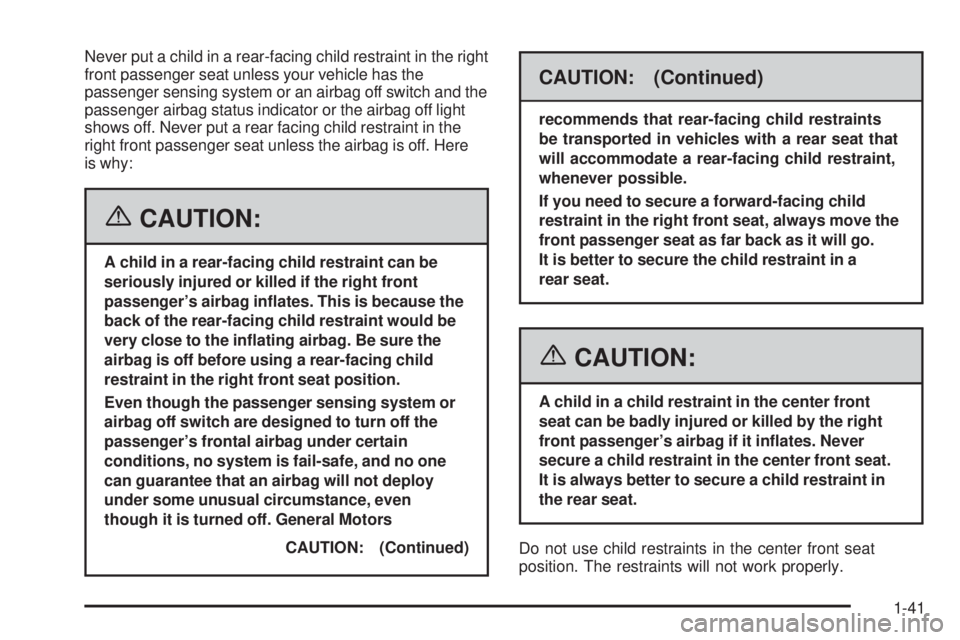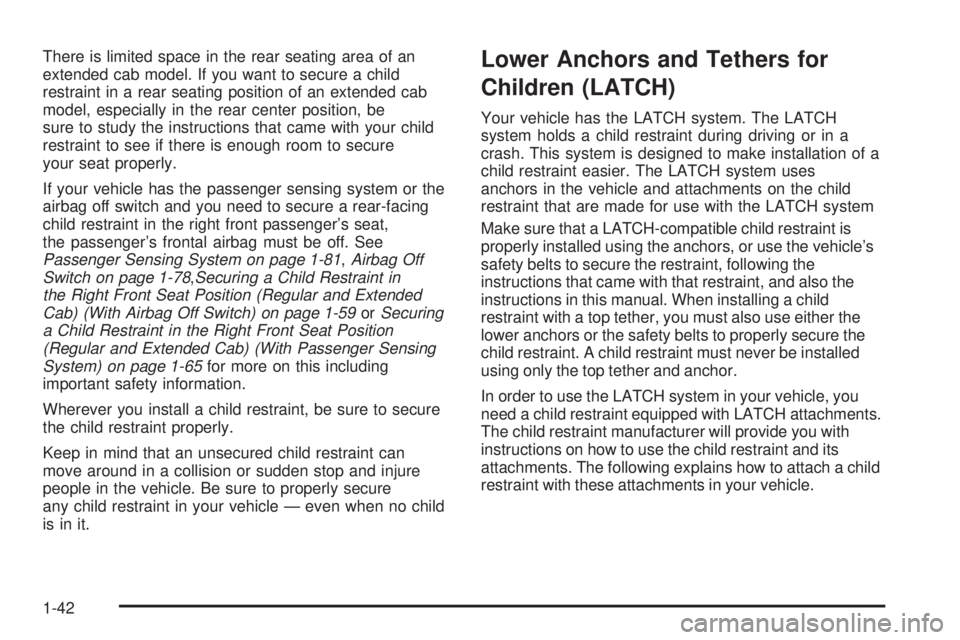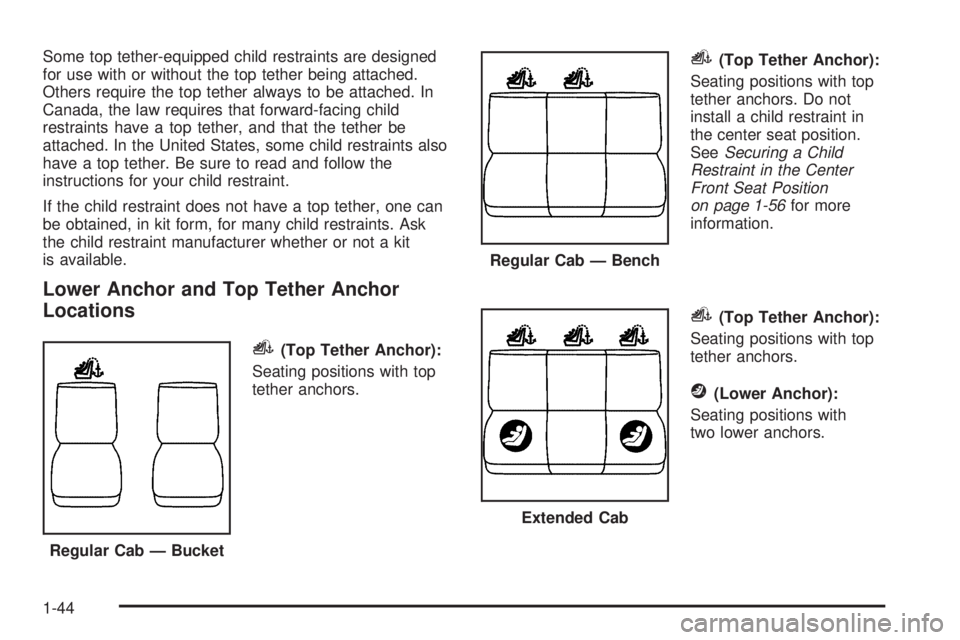Page 47 of 600

Never put a child in a rear-facing child restraint in the right
front passenger seat unless your vehicle has the
passenger sensing system or an airbag off switch and the
passenger airbag status indicator or the airbag off light
shows off. Never put a rear facing child restraint in the
right front passenger seat unless the airbag is off. Here
is why:
{CAUTION:
A child in a rear-facing child restraint can be
seriously injured or killed if the right front
passenger’s airbag in�ates. This is because the
back of the rear-facing child restraint would be
very close to the in�ating airbag. Be sure the
airbag is off before using a rear-facing child
restraint in the right front seat position.
Even though the passenger sensing system or
airbag off switch are designed to turn off the
passenger’s frontal airbag under certain
conditions, no system is fail-safe, and no one
can guarantee that an airbag will not deploy
under some unusual circumstance, even
though it is turned off. General Motors
CAUTION: (Continued)
CAUTION: (Continued)
recommends that rear-facing child restraints
be transported in vehicles with a rear seat that
will accommodate a rear-facing child restraint,
whenever possible.
If you need to secure a forward-facing child
restraint in the right front seat, always move the
front passenger seat as far back as it will go.
It is better to secure the child restraint in a
rear seat.
{CAUTION:
A child in a child restraint in the center front
seat can be badly injured or killed by the right
front passenger’s airbag if it in�ates. Never
secure a child restraint in the center front seat.
It is always better to secure a child restraint in
the rear seat.
Do not use child restraints in the center front seat
position. The restraints will not work properly.
1-41
Page 48 of 600

There is limited space in the rear seating area of an
extended cab model. If you want to secure a child
restraint in a rear seating position of an extended cab
model, especially in the rear center position, be
sure to study the instructions that came with your child
restraint to see if there is enough room to secure
your seat properly.
If your vehicle has the passenger sensing system or the
airbag off switch and you need to secure a rear-facing
child restraint in the right front passenger’s seat,
the passenger’s frontal airbag must be off. See
Passenger Sensing System on page 1-81,Airbag Off
Switch on page 1-78,Securing a Child Restraint in
the Right Front Seat Position (Regular and Extended
Cab) (With Airbag Off Switch) on page 1-59orSecuring
a Child Restraint in the Right Front Seat Position
(Regular and Extended Cab) (With Passenger Sensing
System) on page 1-65for more on this including
important safety information.
Wherever you install a child restraint, be sure to secure
the child restraint properly.
Keep in mind that an unsecured child restraint can
move around in a collision or sudden stop and injure
people in the vehicle. Be sure to properly secure
any child restraint in your vehicle — even when no child
is in it.Lower Anchors and Tethers for
Children (LATCH)
Your vehicle has the LATCH system. The LATCH
system holds a child restraint during driving or in a
crash. This system is designed to make installation of a
child restraint easier. The LATCH system uses
anchors in the vehicle and attachments on the child
restraint that are made for use with the LATCH system
Make sure that a LATCH-compatible child restraint is
properly installed using the anchors, or use the vehicle’s
safety belts to secure the restraint, following the
instructions that came with that restraint, and also the
instructions in this manual. When installing a child
restraint with a top tether, you must also use either the
lower anchors or the safety belts to properly secure the
child restraint. A child restraint must never be installed
using only the top tether and anchor.
In order to use the LATCH system in your vehicle, you
need a child restraint equipped with LATCH attachments.
The child restraint manufacturer will provide you with
instructions on how to use the child restraint and its
attachments. The following explains how to attach a child
restraint with these attachments in your vehicle.
1-42
Page 49 of 600
Your vehicle, except for regular cab models, has lower
anchors and top tether anchors. Your child restraint
may have lower attachments and a top tether.
Not all vehicle seating positions or child restraints have
lower anchors and attachments or top tether anchors
and attachments.
Lower Anchors
Lower anchors (A) are metal bars built into the vehicle.
There are two lower anchors for each LATCH seating
position that will accommodate a child restraint with
lower attachments (B).
Top Tether Anchor
A top tether (A, C) anchors the top of the child restraint
to the vehicle. A top tether anchor is built into the
vehicle. The top tether attachment (B) on the child
restraint connects to the top tether anchor in the vehicle
in order to reduce the forward movement and rotation
of the child restraint during driving or in a crash.
Your child restraint may have a single tether (A) or a
dual tether (C). Either will have a single attachment (B)
to secure the top tether to the anchor.
1-43
Page 50 of 600

Some top tether-equipped child restraints are designed
for use with or without the top tether being attached.
Others require the top tether always to be attached. In
Canada, the law requires that forward-facing child
restraints have a top tether, and that the tether be
attached. In the United States, some child restraints also
have a top tether. Be sure to read and follow the
instructions for your child restraint.
If the child restraint does not have a top tether, one can
be obtained, in kit form, for many child restraints. Ask
the child restraint manufacturer whether or not a kit
is available.
Lower Anchor and Top Tether Anchor
Locations
i(Top Tether Anchor):
Seating positions with top
tether anchors.
i(Top Tether Anchor):
Seating positions with top
tether anchors. Do not
install a child restraint in
the center seat position.
SeeSecuring a Child
Restraint in the Center
Front Seat Position
on page 1-56for more
information.
i(Top Tether Anchor):
Seating positions with top
tether anchors.
j(Lower Anchor):
Seating positions with
two lower anchors.
Regular Cab — Bucket
Regular Cab — Bench
Extended Cab
1-44
Page 52 of 600
For regular cab models with a bench seat, the top tether
anchors are located under trim covers on the back
panel behind the center and passenger seats. Do not
install a child restraint in the center seat position.
SeeSecuring a Child Restraint in the Center Front Seat
Position on page 1-56for more information. For
regular cab models with bucket seats, the top tether
anchor is located under a trim covers on the back panel
behind the passenger seat. Remove the trim plug to
access the anchor.For extended cab models, the top tether anchors are
located near the top of the seatback for each rear
seating position. In addition to the top tether anchors,
each seating position has a fabric loop at the top of the
seatback that you will use to route the top tether
through. Be sure to use an anchor located on the same
side of the vehicle as the seating position where the
child restraint will be placed. Regular Cab
Extended Cab
1-46
Page 53 of 600
For crew cab models, there are covered top tether
anchors for each seating position located on the back
panel of your vehicle, behind the rear seat. Remove the
trim covers to access the anchors.Do not secure a child restraint in the front passenger’s
position if your vehicle has rear seats, if a national
or local law requires that the top tether be attached, or if
the instructions that come with the child restraint say
that the top tether must be attached. There is no place
to attach the top tether in this position.
Accident statistics show that children are safer if they
are restrained in the rear rather than the front seat. See
Where to Put the Restraint on page 1-40for additional
information.
Crew Cab
1-47
Page 54 of 600
Securing a Child Restraint Designed for
the LATCH System
{CAUTION:
If a LATCH-type child restraint is not attached
to anchors, the restraint will not be able to
protect the child correctly. In a crash, the child
could be seriously injured or killed. Make sure
that a LATCH-type child restraint is properly
installed using the anchors, or use the
vehicle’s safety belts to secure the restraint,
following the instructions that came with that
restraint, and also the instructions in this
manual.
{CAUTION:
Each top tether anchor, except the center top
tether anchor in an extended cab model, and
lower anchors in the vehicle are designed to
hold only one child restraint. Attaching more
than one child restraint to a single anchor
could cause the anchor or attachment to come
loose or even break during a crash. A child or
others could be injured if this happens. To
help prevent injury to people and damage to
your vehicle, attach only one child restraint per
anchor.
1-48
Page 56 of 600

2. SeeSecuring a Child Restraint in the Right Front
Seat Position (Regular and Extended Cab) (With
Airbag Off Switch) on page 1-59orSecuring a Child
Restraint in the Right Front Seat Position (Regular
and Extended Cab) (With Passenger Sensing
System) on page 1-65for instructions on installing
the child restraint using the safety belts.
3. Push and pull the child restraint in different
directions to be sure it is secure.
Extended Cab Models
1. Attach and tighten the lower attachments to the
lower anchors. If the child restraint does not have
lower attachments or the desired seating position
does not have lower anchors, secure the child
restraint with the top tether and the safety belts.
Refer to your child restraint manufacturer
instructions and the instructions in this manual.
1.1. Find the lower anchors for the desired
seating position.
1.2. Put the child restraint on the seat.
1.3. Attach and tighten the lower attachments on
the child restraint to the lower anchors.2. If the child restraint manufacturer recommends that
the top tether be attached, attach and tighten the
top tether to the top tether anchor, if equipped.
Refer to the child restraint instructions and
the following steps:
2.1. When using a child restraint with a top tether
in the rear driver’s side position, raise the
head restraint and route the top tether
through the fabric loop and under the center
shoulder belt. Then, attach the top tether
to the metal anchor point at the center rear
seating position.
1-50